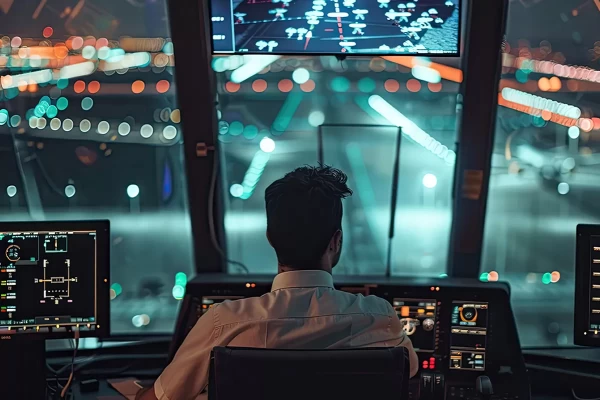Air Traffic Control (ATC): How It Ensures Safe Skies

Table of Content:
What is Air Traffic Control?
Key Steps in Air Traffic Control for Ensuring Safe Skies
- Training and Certification of Air Traffic Controllers
- Use of Advanced Technology
- Coordination and Communication
- Traffic Management
- Weather Monitoring and Reporting
- Emergency Handling
Conclusion
Look up–notice how the planes seem to take a similar curved pathway through the sky of your town. Every flight we spot daily is strategically planned, routed out, and guided by Air Traffic Controllers from the control tower in the airport.
Modern Aviation systems heavily rely on expert Air traffic control (ATC), from takeoff to landing. They ensure the safe and efficient movement of aircraft across the world. The complex and highly coordinated efforts of air traffic controllers enable millions of flights to operate smoothly each year, even in the most challenging conditions. For passengers, the complexities and sheer necessity of ATC often remain behind the scenes, yet it plays a crucial role in maintaining safety, preventing collisions, and managing proper air traffic. In Nepal, where diverse landscapes and weather patterns present unique challenges, air traffic control is particularly vital. This article explores how air traffic control works, the steps involved in ensuring safe skies, and the significance of ATC in managing air traffic in Nepal.
What is Air Traffic Control?
Air traffic control (ATC) is a critical service in the aviation industry, responsible for the safe and efficient movement of aircraft both on the ground and in the sky. ATC's primary goal is to prevent collisions and organize and expedite the flow of air traffic while providing information and other support to pilots. The air traffic control system comprises various components and technologies that work together to ensure that aircraft can travel safely from one destination to another.
Air traffic controllers are highly trained professionals who manage this complex system. They monitor and direct aircraft using radar, radio communication, and other tools, providing instructions to pilots for takeoff, landing, and en route navigation. In Nepal, air traffic control plays a vital role in managing the country's busy airspace, ensuring safe operations amidst the challenging terrain of hills and mountains with sudden unpredictable weather conditions. The complexities of air traffic in Nepal require a professional ATC system and well-trained controllers to handle the unique demands of the region.
Key Steps in Air Traffic Control for Ensuring Safe Skies
1. Training and Certification of Air Traffic Controllers
Air traffic control training is rigorous and comprehensive, designed to equip controllers with the skills and knowledge needed to manage air traffic safely.
In Nepal, ATCs undergo extensive training programs that include theoretical instruction, simulation exercises, and on-the-job training. They learn about aviation regulations, meteorology, navigation, aircraft performance, and emergency procedures. Certification is mandatory, and controllers must pass stringent exams and continuous assessments to maintain their qualifications.
2. Use of Advanced Technology
The air traffic control system relies on advanced technology to monitor and manage aircraft. Radar systems track the position, speed, and altitude of aircraft, providing real-time data to controllers. Communication systems enable continuous contact between controllers and pilots, ensuring that instructions and information are relayed promptly and accurately.
Also Read: Guide on Flight Data Monitoring.
In Nepal, the implementation of modern ATC technologies, such as Automatic Dependent Surveillance-Broadcast (ADS-B) and satellite-based navigation systems, has enhanced the efficiency and safety of air traffic management.
3. Coordination and Communication
Effective coordination and communication are crucial components of air traffic control. Controllers work closely with pilots, ground staff, and other ATC units to ensure smooth operations.
This coordination is particularly important in Nepal, where the mountainous terrain and variable weather conditions require precise and timely communication to avoid hazards. Controllers provide pilots with vital information on weather conditions, traffic patterns, and potential obstacles, enabling them to make informed decisions during flight.
4. Traffic Management
Managing the flow of air traffic is a complex task that involves sequencing and spacing aircraft to maintain safe distances. Controllers use traffic management techniques to prevent congestion and delays, ensuring that aircraft can take off, fly, and land smoothly. In busy airspace like that of Nepal, efficient traffic management is essential to accommodate the high volume of domestic and international flights. Controllers must balance the demands of commercial airlines, private aircraft, and military operations while maintaining safety and efficiency.
5. Weather Monitoring and Reporting
Weather conditions have a significant impact on air traffic operations. Controllers monitor weather patterns continuously and provide pilots with updates on conditions such as wind speed, visibility, turbulence, and storms.
You may also like: What Causes Turbulence in an Aircraft?
In Nepal, where weather can change rapidly and dramatically, accurate and timely weather reporting is crucial for safe flight operations. Controllers use weather radar, satellite data, and meteorological forecasts to anticipate and respond to adverse weather conditions, minimizing the risk of weather-related incidents.
6. Emergency Handling
Air traffic controllers are trained to handle emergencies and unexpected situations with professionalism and efficiency. In the event of an emergency, such as an engine failure, medical issue, or severe weather, controllers provide pilots with critical support and guidance. They coordinate with emergency services, facilitate priority landing, and ensure that other aircraft are aware of the situation to avoid further complications.
In Nepal, where airports are often located in challenging environments, the ability to manage emergencies effectively is paramount.
Conclusion
Air traffic control is the centre around which the aviation industry revolves. It ensures the safety and efficiency of air travel. The role of air traffic controllers, the use of advanced technology, and the importance of effective communication and coordination cannot be overstated. In a country like Nepal, with its unique geographical and meteorological challenges, the air traffic control system is vital in maintaining safe skies.
